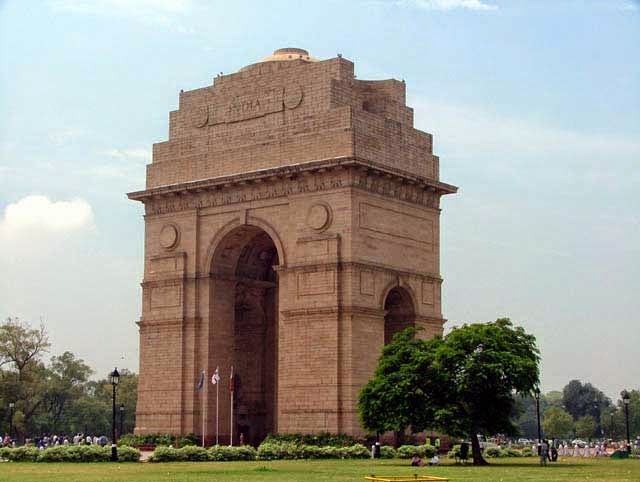Thursday, 12 February 2015
The Delhi Memorial – India Gate
The Delhi Memorial, also known as India Gate, stands at the eastern end of Rajpath or Kingsway. It is situated in the heart of New Delhi. India Gate was designed by Sir Edwin Lutyens and unveiled by Lord Irwin on 12th February 1931.
It was named “All India War Memorial” but later changed the name to India Gate. Indian Gate commemorates the soldiers of Indian Army who lost their lives while fighting as British allies in the First World War and the Third Anglo-Afghan War.
13,300 Commonwealth servicemen are commemorated by name. The Delhi Memorial also acts as a national memorial to all the 70,000 soldiers of Undivided India who served and died during the First World War.
Burning in a shrine under the arch of India Gate since 1971 is the Amar Jawan Jyoti (the flame of the immortal soldier) which marks the Tomb of the Unknown Soldier.
Wednesday, 4 February 2015
WW1 - Deaths of Indians in Brighton Hospitals
Over one and a half
million Indian army soldiers served alongside British troops during the World
War One. Twelve thousand Indian soldiers who were wounded on the Western Front
were hospitalised at sites around Brighton. These included York Place School,
the Dome, the Corn Exchange and the Royal Pavilion.
The fifty-three
Hindu and Sikh soldiers who died in Brighton were taken to a peaceful resting
place on the Sussex Downs near Patcham for cremation, after which their ashes
were scattered in the sea, in accordance with their religious rites.
The Muslim brothers in arms, totalling nineteen, were buried in a purpose built burial ground near to the Shah Jehan Mosque in Woking. Built in 1889, the mosque is the oldest of its kind in north-west Europe.
The Muslim brothers in arms, totalling nineteen, were buried in a purpose built burial ground near to the Shah Jehan Mosque in Woking. Built in 1889, the mosque is the oldest of its kind in north-west Europe.
Deaths of Indians in Brighton Hospitals:
Kitchener Hospital:
36 deaths - 25 Hindus/Sikhs cremated at Patcham; 11 Mohammedans buried at Woking.
Royal Pavilion:
Kitchener Hospital:
36 deaths - 25 Hindus/Sikhs cremated at Patcham; 11 Mohammedans buried at Woking.
Royal Pavilion:
18 deaths - 10
cremated at Patcham; eight buried at Woking.
York Place Hospital:
York Place Hospital:
20 deaths - 18
cremated at Patcham; 2 buried at Woking.
|
Total cremated on the Downs at Patcham
|
53
|
|
Total buried at Jehan Mosque in Woking
|
21
|
|
Total deaths
|
74
|
The Gurkha Memorial
On 3rd December 1997, British memorial to the Gurkhas was uneviled in London by HM The Queen, on Horse Guards Avenue.
Photo: Commonwealth War
Graves Commission
The inscription is a quotation from Sir Ralph Turner, a former officer in the 3rd Gurkha Rifles.
THE GURKHA SOLDIER
Bravest of the brave,
most generous of the generous,
never had country
more faithful friends
than you.
Bravest of the brave,
most generous of the generous,
never had country
more faithful friends
than you.
Sunday, 1 February 2015
Indian soldiers and food during WW1
WW1 – What did Indian soldiers eat during WW1
· 1⁄4 pound meat
(Non-meat eaters received 2 ounces of gur (coarse, unrefined sugar made from sugar cane juice) or sugar or 3 ounces of milk in place of 4 ounces of meat)
· 1⁄8 pound potatoes
· 1⁄3 ounce tea
· 1⁄2 ounce salt
· 1 1⁄2 pounds atta (flour)
· 4 ounces dhal (dried lentils, peas or beans which have been stripped of their outer hulls and split)
· 2 ounces ghee (clarified butter)
· 1⁄6 ounce chillies
· 1⁄6 ounce turmeric
· 1⁄3 ounce ginger
· 1⁄6 ounce garlic
· 1 ounce gur
Indian troops' iron rations (emergency supplies issued in case soldiers were cut off from regular rations) consisted of:
· 1 pound biscuit
· 8 ounces gur
· 1 ounce tea
· 6 ounces condensed milk or 21⁄2 ounces dried milk in lieu, when available.
Subscribe to:
Comments (Atom)



